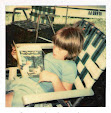The World's Best One Hundred Detective Stories Vol. Eight (1910) by Eugene Thwing, ed
"The Last Exploit of Harry the Actor" by Ernest Bramah: Features his blind detective Max Carrados in a mystery about the robbery from several safe deposit boxes in a Lucas Street depository known colloquially as "The Safe." The contents of the boxes are held safe behind multiple barriers--both real locks and bars as well as secret passwords known only to the owners. And yet...a large number of the boxes are plundered. Carrodos, whose other faculties have become stronger to compensate for the loss of his sight, is able to "see" the solution to the mystery very quickly.
"The Comedy at Fountain Cottage" by Ernest Bramah: Carrados is intrigued when his friend Louis Carlyle tells him about his niece's odd neighbor--a neighbor who tosses stewed kidneys over the fence at night. When he digs into the history of Fountain Cottage he learns some interesting facts about the previous owner and what the odd neighbor might have planned. [one natural]
"The Curious Circumstance of the Two Left Shoes" by Ernest Bramah: When the Enderleigh's silver is stolen--apparently by the Monkey Burglar, Carrodos arrives to track down the real culprit.
"The Jeweled Casket" by Arthur Somers Roche: An "artist" in thievery, John Ainsley, steals from the thieves and gives...to himself. He loves outwitting the White Eagle, one of those supercrooks who thinks he's unstoppable. In this episode, Ainsley plots to get hold of a fabulous jeweled box that the White Eagle has just gotten his hands on. [two natural]
"The Club of One-Eyed Men" by Arthur Somers Roche: John Ainsley is at it again. He sees the White Eagle in close conversation with an American millionaire at a Parisian nightclub. Then sees the criminal mastermind the next day on a street full of men with only one eye. When he finds himself onboard a New York-bound steam ship with the millionaire and one of the one-eyed men, he finds himself set up to take advantage of another White Eagle criminal plot.
"The Pigtail of Hi Wing Ho" by Sax Rohmer: Hi Wing Ho becomes embroiled in a series of mysterious events that threaten his life and the lives of those around him. He is pursued by a group of criminals who are after a valuable artifact that our hero possesses.
"The Story of O Toyo" by H. de Vere Stacpoole: When some con artists attempt an impersonation of a jeweler, the young Japanese woman who is his servant sees through their plot.
"The Tragedy at St. Tropez" by Gilbert Frankau: When a wealthy financier is poisoned everything points towards his secretary. But the man brought in to translate French for the investigators, can't believe his old school friend is guilty. [one poisoned]
These last two are like "minute mysteries"--the readers are given the story and then supposed to figure out the solution. The authors vary from the very obvious (the first) to impossible to tell how it was done even though the culprit is again obvious (the last).
"The Crawley Robbery" by Evelyn Johnson & Gretta Palmer: A wealthy couple bring home the family jewels so the wife can wear them to a special dinner. While she is dressing the emeralds disappear. Who did it?
"Finger Prints Can't Lie" by Evelyn Johnson & Gretta Palmer: The wife of a German spy is poisoned. The fingerprints on the bottles (poison and the wife's medicine bottle) belong to the maid. Is she guilty? If not, who did it and why aren't the fingerprints telling the truth? [one poisoned]









.jpg)
.jpg)



.jpg)

.jpg)
.jpg)
































